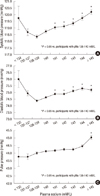Abstract
Figures and Tables
 | Fig. 1Distribution of systolic blood pressure (SBP), diastolic blood pressure (DBP), and pulse pressue (PP) according to plasma sodium (pNa) levels. (A) SBP according to pNa levels. SBP in participants with pNa ≥ 141 mM/L was significantly higher than in pNa 138-139 mM/L (P = 0.002), and SBP was not significantly different among participants with pNa < 134 and pNa 138-139 mM/L. The SBP is adjusted by age, estimated glomerular filtration rate, body mass index, total serum cholesterol, protein, calcium, phosphorus, glucose, potassium, HDL cholesterol, and alkaline phosphatase using co-variance analysis (ANCOVA). Error bars indicate the standard error of the mean. (B) DBP according to pNa levels. DBP in participants with pNa ≥ 141 mM/L was significantly higher than in participants with pNa 138-139 mM/L (P < 0.001). The DBP is adjusted by age, estimated glomerular filtration rate, body mass index, total serum cholesterol, protein, calcium, phosphorus, glucose, potassium, HDL cholesterol, and alkaline phosphatase using co-variance analysis (ANCOVA). Error bars indicate the standard error of the mean. (C) PP according to pNa levels. Only pulse pressure (PP) in pNa ≥ 145 mM/L participants was significantly higher than in pNa 138-189 mM/L participants. The PP is adjusted by age, estimated glomerular filtration rate, body mass index, total serum cholesterol, protein, calcium, phosphorus, glucose, potassium, HDL cholesterol, and alkaline phosphatase using co-variance analysis (ANCOVA). Error bars indicate the standard error of the mean. *P < 0.05 vs participants with pNa 138-140 mM/L. |
 | Fig. 2The distribution of systolic blood pressure (SBP) according to sodium groups stratified by age and gender. The SBP is adjusted by age, estimated glomerular filtration rate, body mass index, serum total cholesterol, protein, calcium, phosphorous, glucose, potassium, HDL cholesterol, and alkaline phosphatase using co-variance analysis (ANCOVA). Error bars indicate the standard error of the mean. *P < 0.05 vs participants with pNa 138-140 mM/L. |
 | Fig. 3The distribution of systolic blood pressure (SBP) according to sodium groups in participants with and without components of metabolic syndrome. The SBP is adjusted by age, estimated glomerular filtration rate, body mass index, serum total cholesterol, protein, calcium, phosphorous, glucose, potassium, HDL cholesterol, and alkaline phosphatase using co-variance analysis (ANCOVA). Error bars indicate the standard error of the mean. *P < 0.05 vs participants with pNa 138-140 mM/L. |
 | Fig. 4Survival curves for all-cause mortality of all participants and women aged ≥ 50 yr according to sodium groups. (A) All participants. The participants were categorized according to plasma sodium: group 1, 138-140 mM/L; group 2, 141-142 mM/L; group 3, 143-144 mM/L; and group 4, ≥ 145 mM/L. (B) Women aged ≥ 50 yr. |
Table 1

*P<0.05; †P<0.001; ‡CRP was measured in 77,957 participants; §Urine protein measured by dipstick test; ∥The data of CAD history exists in only 66,888 participants. BMI, body mass index; BUN, blood urea nitrogen; Creatinine, IDMS traceable serum creatinine; eGFR, estimated glomerular filtration rate; CRP, C-reactive protein; ESR, erythrocyte sediment rate; ALT, alanine transferase; AST, aspartate transferase; ALP, Alkaline phosphatase; γGT, gamma glutamyl transferase; HDL, high density lipoprotein cholesterol; Glucose, fasting glucose; HbA1c, Hemoglobin A1c; CAD, coronary artery disease; No. of MS component, Number of criteria for metabolic syndrome.




 PDF
PDF ePub
ePub Citation
Citation Print
Print



 XML Download
XML Download